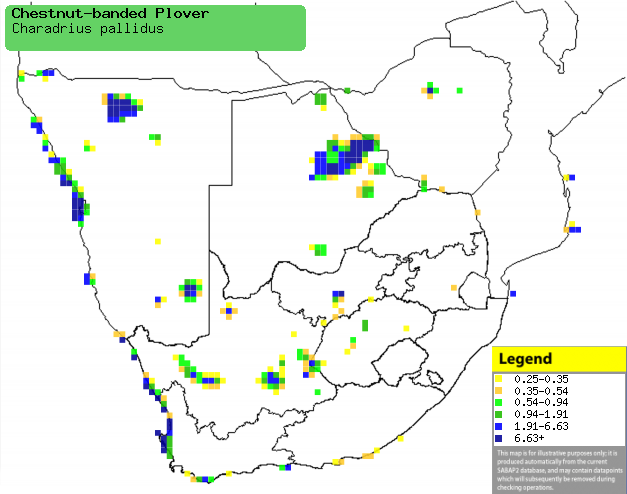|
Charadrius pallidus
(Chestnut-banded plover)
Rooibandstrandkiewiet [Afrikaans]; Kaapse plevier [Dutch];
Pluvier élégant [French]; Fahlregenpfeifer [German];
Borrelho-de-colar-arruivado [Portuguese]
Life
> Eukaryotes >
Opisthokonta
> Metazoa (animals) >
Bilateria >
Deuterostomia > Chordata >
Craniata > Vertebrata (vertebrates) > Gnathostomata (jawed
vertebrates) > Teleostomi (teleost fish) > Osteichthyes (bony fish) > Class:
Sarcopterygii (lobe-finned
fish) > Stegocephalia (terrestrial
vertebrates) > Tetrapoda
(four-legged vertebrates) > Reptiliomorpha > Amniota >
Reptilia (reptiles) >
Romeriida > Diapsida > Archosauromorpha > Archosauria >
Dinosauria
(dinosaurs) > Saurischia > Theropoda (bipedal predatory dinosaurs) >
Coelurosauria > Maniraptora > Aves
(birds) >
Order: Charadriiformes > Family: Charadriidae
> Genus: Charadrius
Distribution and habitat
Occurs in the Rift Valley lakes of southern Kenya and
northern Tanzania, with a separate population in south-west Angola and southern
Africa. Within southern Africa it is locally common along the west coast of the
region, as well as in patches of northern Namibia and eastern Botswana, while more scarce in Zimbabwe,
coastal Mozambique and inland South Africa. It generally prefers natural coastal embayments and man-made salt pans, occasionally moving to coastal lagoons,
shallow bays and estuaries.
|
 |
|
Distribution of Chestnut-banded plover in southern Africa,
based on statistical smoothing of the records from first SA Bird Atlas
Project (©
Animal Demography unit, University of
Cape Town; smoothing by Birgit Erni and Francesca Little). Colours range
from dark blue (most common) through to yellow (least common).
See here for the latest distribution
from the SABAP2. |
Movements and migrations
Little known, it is thought to be a resident
and partial migrant, sometimes travelling inland when coastal pans
dry up.
Food
It mainly eats insects and small crustaceans (such as brine
shrimps, Artemia), foraging in the manner typical of plovers, running,
stopping, searching then grabbing its prey before repeating the process.
Breeding
- Monogamous, territorial solitary nester, defending a territory of 20-100
metres of pan shoreline against other breeding pairs and waterbird species.
- The nest is a scrape in the ground lined with quartz chips, clay shards,
grass, fish bones and small gastropods shells.
- Egg-laying season in the Western Cape from September-February, peaking
from November-December, while elsewhere in southern Africa egg-laying season
is from
March-October.
- It usually lays two eggs, which are mainly incubated by the female
during the day and by the male in the evenings.
- The chick are often held under the wings of their
parents, eventually fledging at about 28-33 days old.
Threats
Near-threatened in South Africa, although its
overall population is increasing due to the construction of commercial salt
pans.
References
-
Hockey PAR, Dean WRJ and Ryan PG 2005. Roberts
- Birds of southern Africa, VIIth ed. The Trustees of the John Voelcker
Bird Book Fund, Cape Town.
|
